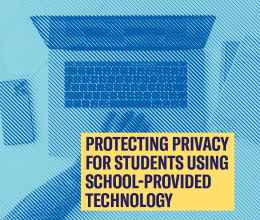
By: Stephen Ragan, Policy and Advocacy Strategist: Privacy, Technology and Surveillance
The right to protest is a fundamental constitutional right enshrined in both the U.S. Constitution and the Illinois Constitution. The First Amendment guarantees the essential right to assemble peacefully to advocate for any cause. The Illinois’ Constitution goes further guaranteeing the right to “make known their opinions to their representatives” and “to consult for the common good.”
Protest is a critical tool to hold administrations accountable and express potential avenues for advancing a shared vision of a better future. This month, Chicago will host the Democratic National Convention. That responsibility includes respecting the constitution and protecting those that wish to exercise their rights without engaging in invasive surveillance. This will require an even-handed approach that cuts against the city’s history of spying on those engaged in constitutionally protected activities, including the Chicago Police’s infamous “Red Squad.”
Surveillance Chills First Amendment Guarantees
National political conventions provide an outlet for speech and expression on issues of concern both locally and nationally. Despite this, public officials have attempted to limit expression in and around conventions. The ACLU of Illinois has advocated and litigated to ensure that ability of protesters to be present within the sight and sound of delegates.
Local officials can reduce tensions and advance public safety without policies that outright prevent expression and association or resort to intrusive forms of government surveillance. Government surveillance itself has a chilling effect on our rights to speak freely and associate with who we want. Courts have long recognized that even where government does not explicitly ban expression, efforts to deter or chill speech can be constitutional violations.
When we are aware we are being observed we act differently and engage in self-censorship. This threat is ratcheted up when our opinions are in the minority. The threats to our civil liberties have only become greater as surveillance technology has expanded to meet law enforcement demands.
Protest Surveillance
The power of the government to surveil, investigate, prosecute, and intimidate us is vast. These harmful practices should stop but until then protesters, activists, and really all of us must take precautions to protect our privacy and the privacy of our associates. To do this it is good to be aware of the mix of surveillance technology that can be used to identify protestors.
We know the CDP has many surveillance tools that they could use to monitor a protest. So far we do not know what technology they might be using during the DNC, but it could include:
- Location/Travel Monitoring
- Automated License Plate Readers are installed throughout the city and track every automobile as it moves throughout Chicago;
- Public transit travel linked to a credit card or an account can the location of those leaving from a protest event;
- Cashless toll data is easily accessible by law enforcement for tracking those traveling to the city;
- Mobile Devices can leave a data crumb trail by:
- automatically connecting to cell-site simulators;
- location services like maps and other apps that track your location;
- posted videos or photographs include metadata revealing the time and location of photos.
- Body-worn cameras
- Record the words, and actions, and locations of events. Some body-worn cameras include facial recognition technology.
- Drones/Helicopters
- Equipped with video cameras, infrared, heat sensors, ALPRs, and radar providing persistent surveillance.
- Mobile Device seizure and data extraction
- Law enforcement need consent or a warrant to search your mobile device. You do not have to consent and you should disable face and finger unlock features;
- Companies like Cellebrite and Greysmith sell tools to crack encryption on cellphones to extract data.
- Surveillance Cameras: the city’s surveillance camera system links 30,000+ cameras equipped with:
- Zoom capacity allowing operators to see small objects and features at great distances or magnify them.
- Facial recognition and other characteristic identification like tattoos or a particular gait.
- Automatic tracking to follow a particular person or vehicle from one camera to the next.
- Mobile Surveillance Trailers and Towers
- These will be transported and elevated to monitor protests. They are often equipped with cameras, spotlights, speakers, ALPRs and sometimes are big enough for an officer to sit inside.
- Fusion Centers – Chicago’s Crime Prevention Information Center and Illinois’ Statewide Terrorism and Intelligence Center
- These will be used to monitor tech and are the command center for the in and out flow of information.
- Social Media Monitoring
- In 2020, the Chicago Police Department created a Confidential Analytics Section (Unit 195) within its Counterterrorism Division of the Bureau of Counterterrorism to monitor social media activity for both public and private accounts.
- Stingrays – Cell Site Simulators
- Trick mobile devices within a certain radius into connecting to a fake cell-phone tower to pinpoint the location of mobile devices and some have advanced features to intercept communications.
- Mobile Device Jammers
- That can shut down or disrupt.
- Geofence Warrants for areas near protest
- Geofencing warrants are made by law enforcement to organizations like Apple and Google to identify all devices that were within a specific geographic location during a specified time period.






